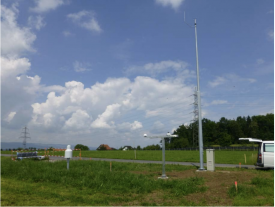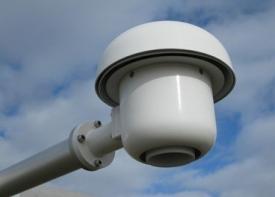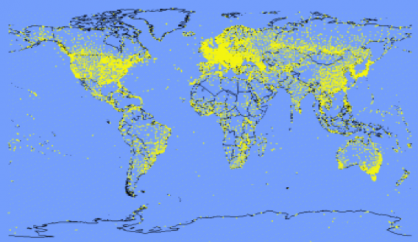What is temperature?
Temperature is a physical quantity that describes
hotness or coldness and is proportional to the average kinetic energy of a mass.
Thermometers are used to measure the
temperature. These can be standardised to one of three scales:
- the Fahrenheit scale (° F), which is especially popular in the US
- the Celsius scale (° C), which is the most commonly used worldwide
- the Kelvin scale (K), which is the SI unit for temperature
The Kelvin and the Celsius scale have exactly the same intervals for a temperature difference of 1 °, they differ only by their zero point.
In meteorology, we commonly distinguish between air temperature (near the surface or in altitude),surface temperature, soil temperature and water temperature and temperature in altitude. Generally, when talking about "temperature", the air temperature is considered. In meteorology, as a rule, the air temperature is considered. Often day or night temperatures are given to describe the weather of a day.
In addition, it should be noted that temperature is highly dependent on altitude. On average, the air cools by about 1°C per 100m elevation increase. Therefore, it is important to know at which altitude the measuring station is located and at which height the temperature sensor is fixed. In this way, the altitude of the station and the height of the instrument relative to the ground can be considered correctly.
How is temperature measured?
All thermometers take advantage of various physical properties of fabrics that change with changes in temperature. This can be, for example, the increase in volume of a liquid, the electrical resistance of a metal or the change in the volume of a metal.
According to WMO (World Meteorological Organization), weather stations for measuring air temperature are the most commonly used devices with electrical resistance. The temperature is measured in an interval of a few seconds, from which then a 5-minute average is formed. At the full hour, these 5-minute funds are then aggregated to an hourly average. For non-automated - mostly private - stations, the measurement interval can also be one hour or even one day.
How should the thermometer of a weather station be set up?

According to WMO standards, a thermometer for measuring the air temperature must be placed on a level surface (ideally short cut grass) and two meters above the ground. The measuring environment must be subject to direct sunlight, and no major obstacles (trees, buildings) affecting the circulation of air may be nearby. For the measurement to actually measure the temperature of the air, the thermometer has to be in a well-ventilated white protective box. This protection ensures that no direct radiation can hit the device, which would heat it more than the ambient air. The ventilation can be provided either naturally with the help of slats or artificially with the help of fans. To measure the temperature at different heights from the ground, measuring masts up to about 300m high are used. For measurements above 300m, weather balloons are used.
Which measuring instruments are used to measure the air temperature?
National meteorological services, such as MeteoSwiss, mostly use one of the two following devices to measure temperature:

Figure 2: Protective white box of a temperature sensor
- An instrument with a copper constantan thermocouple
- An instrument with a platinum resistance thermometer (PT100)
The device with the PT100 sensor is the newer of the two used and is replacing the other.
The PT100 sensor responds to the change in conductivity of the metal platinum. The copper-constantan element, on the other hand, generates a very small voltage proportional to the temperature of the element's solder joint due to the Seebeck effect.
Which other measuring methods are available?

Figure 3: High precision mercury thermometer
The sensors found in any digital home thermometer are based on the same principle as the professional equipment: a conductive material, whose resistance is temperature dependent is used.
Classic old-fashioned thermometers use mercury, which - thanks to its low heat capacity - increases or decreases its volume even for low temperature changes. However, these thermometers can not be automated and the accuracy is highly dependent on the observer reading the value.
Another outdated method of temperature determination is the bimetallic method. Two metal plates with different coefficients of thermal expansion are stapled together. When heated, the plates deform at different rates and it is possible to calculate the change in temperature by the different expansion of the plates.
Difficulties of temperature measurement
The biggest measurement errors are caused by wrong installation of the instruments. If the measuring instruments are positioned too close to the ground, they do not only measure the air temperature, but also the heat which is emitted by the ground. Also, if a device is directly exposed to sunlight, the measurements will be too high. Ventilation must not be neglected, because standing air heats up a lot faster than moving air. Thus, complete calm in the box of the measuring instrument, will lead to values that are too high in the case of solar radiation.
If the temperature sensor is installed above a tar or asphalt surface, the measurement results will also be impacted as these surfaces (unlike grass) strongly heat up extremely as a result of solar radiation. For uniform and thus intercomparable measurements, it is therefore essential to follow the rules of the WMO.
How many measuring stations are there?
In Switzerland, there are more tha 150 official measuring stations managed MeteoSwiss which measure the air temperature. However, due to the complex terrain and associated strong temperature gradients, this station density is not high enough for a nationwide measuring network that captures all temperature peculiarities.
Because of this, meteoblue also uses numerous private measuring stations, which are evaluated and checked for completeness of the data in order to offer services such as Nowcast or the weather maps in more detail. Such stations, do however not necessarily conform to WMO standards, which is why all measurements undergo automated quality controls before being used for forecasting or other purposes.

According to the National Oceanic and Atmospheric Administration (NOAA), there are currently over 14,000 active weather stations operating daily that meet all WMO standards. Most of them are in the US and Europe. meteoblue uses about 70,000 weather stations worldwide, where in addition to the WMO stations, other public and private networks are used. There are well over 100,000 private weather stations that measure and record weather data. Considering all temperature sensors installed in cars, smartphones and other electronic devices, several million temperature sensors are in circulation, with a strong upward trend.



